Contribute
| India: Prehistory And Indus Period - Language And Literature |
Prem Nagar
01/07/2021
India: Prehistory and Indus Period - Language and Literature The symbols can be grouped into about 400 to 600 characters (Fig. 2), which have not yet been deciphered, but are assumed to be associated with a logo-syllabic representation. Ten Indus characters (Fig. 3) from the northern gate of Dholavira are dubbed as making a signboard that displays one of the longest known sequences of characters. The direction of writing is assumed to be from right to left, because of the cramping of signs observed toward the left end of the character string and the free space More than a hundred attempts have been made to decipher the Indus symbols. A typical effort is shown in (Fig. 4) where a Mohenjo-daro seal is read, based on the Gondi language, and is represented in phonetic sounds. Script is a hallmark of civilization. Findings of musical instruments, town organization, water management and engineering point to the existence of a literary heritage that was passed through conventions and symbols in society. Engineering designs and construction would have needed record-keeping and measurements. Rituals and faith systems suggest the existence of religious literature, either oral or written. The Indus script has not yet been deciphered. No bilingual tablet has been found, though the script hint connecting to the writing of a language is suggested by Jonathan Mark Kenoyer.[i] Asko Parpola suggests that the script is an early member of the Dravidian language family.[ii] --------------------------------------------------------------------------------------- [ii] Asko Parpola Deciphering the Indus Script, Cambridge University Press, 1994 [iii] Iravatham Mahadevan, Indus Age: The Writing System, edited by Gregory L. Possehl, University of Pennsylvania Press, 1997 [iv] Suzanne Redalia https://swarajyamag.com/culture/how-i-deciphered-the-indus-valley-script, 2016 --------------------------------------------------------------------------------------- Mr. Prem Nagar leads the Language and Literature track in India Discovery Center's project on "Evolution of Indian Culture: Pre-history to 1947AD". More information and updates on the project are available at Information on India Discovery Center is at (c) Copyright 2021 India Discovery Center, Inc. All rights Reserved.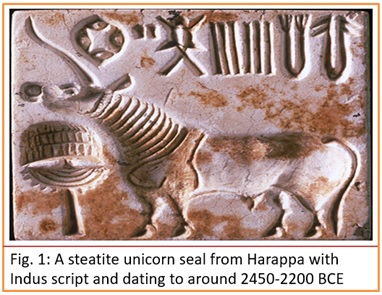 The Bhimbetka rock shelters in central India have a repository of rock paintings (see Art and Culture, Track II) dated to 40,000 years ago. Smaller stylized figures with body ornaments from the Mesolithic Period also provide an early record of creative expression. Prolific use of straight lines, circles, triangles, squares, rectangles and various drawings of animals and events suggest that the inhabitants were able to depict daily life with the use of carving tools. Color pigments were also in use.
The Bhimbetka rock shelters in central India have a repository of rock paintings (see Art and Culture, Track II) dated to 40,000 years ago. Smaller stylized figures with body ornaments from the Mesolithic Period also provide an early record of creative expression. Prolific use of straight lines, circles, triangles, squares, rectangles and various drawings of animals and events suggest that the inhabitants were able to depict daily life with the use of carving tools. Color pigments were also in use. 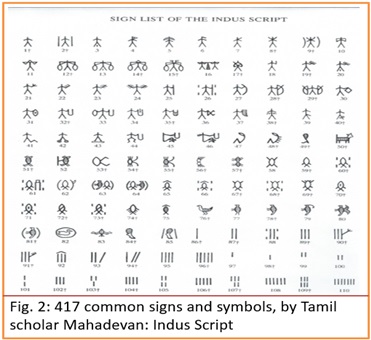 The Indus Civilization is estimated to have commenced around 5000 BCE and to have flourished until about 2000 BCE. More than four thousand artifacts, including seals (Fig. 1), stamps, templates, amulets, and door hangings in copper, silver, gold and terracotta have been excavated from archaeological sites in a wide stretch of the land in this area. The artifacts have impressions of animals like unicorns, bulls, goats, tigers, buffaloes, elephants, as well as glyphs of fish symbols and water jars. A string of glyphs may indicate the general use of a script. The seals are interpreted as labels on grain sacks in packing food articles like barley, rice, as well as articles for export. (see in Economy and Politics, Track VI)
The Indus Civilization is estimated to have commenced around 5000 BCE and to have flourished until about 2000 BCE. More than four thousand artifacts, including seals (Fig. 1), stamps, templates, amulets, and door hangings in copper, silver, gold and terracotta have been excavated from archaeological sites in a wide stretch of the land in this area. The artifacts have impressions of animals like unicorns, bulls, goats, tigers, buffaloes, elephants, as well as glyphs of fish symbols and water jars. A string of glyphs may indicate the general use of a script. The seals are interpreted as labels on grain sacks in packing food articles like barley, rice, as well as articles for export. (see in Economy and Politics, Track VI) 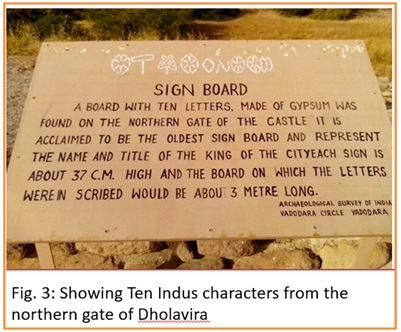 at the right end. Frequent occurrence of signs like a “Jarâ€
at the right end. Frequent occurrence of signs like a “Jar†![]() and a “diamondâ€
and a “diamond†![]() could suggest the start and end of the phrase. Pure vertical strokes likely represent numbers. Language written in symbols likely started with the depiction of pictures, which later developed into a logograph.
could suggest the start and end of the phrase. Pure vertical strokes likely represent numbers. Language written in symbols likely started with the depiction of pictures, which later developed into a logograph. 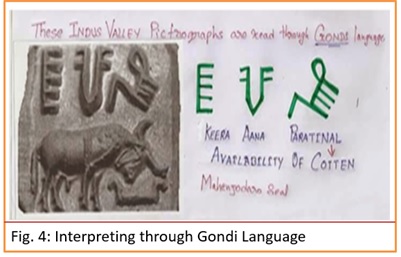 Commercial connections with Indus have been found in Sumerian documents, written in cuneiform inscription. The word Meluhha is used and refers to the land of Indus, while the word Meluhhaites refers to the people of the Indus area. The cuneiform script of Mesopotamia (3200 BCE) was in pictorial form, and represented the counting and recording of goods. Trading activities suggest wide use of oral and written communication. A system of standardized weights and measurements were in use and manuals as well as bills of sales were likely kept. Extensive use of numbers might be speculated.
Commercial connections with Indus have been found in Sumerian documents, written in cuneiform inscription. The word Meluhha is used and refers to the land of Indus, while the word Meluhhaites refers to the people of the Indus area. The cuneiform script of Mesopotamia (3200 BCE) was in pictorial form, and represented the counting and recording of goods. Trading activities suggest wide use of oral and written communication. A system of standardized weights and measurements were in use and manuals as well as bills of sales were likely kept. Extensive use of numbers might be speculated.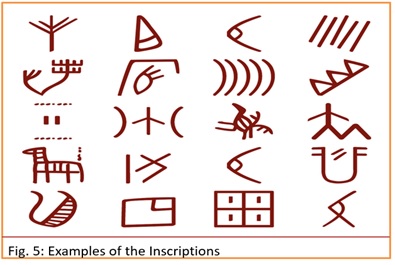 It is fair to assume that the Indus script (Fig. 5) was used by several languages that were used in the area. Prof. Iravatham Mahadevan has compiled 417 common signs, and suggests that Indus might have encoded Brahui, a language of North Dravidian that shares the Kurukh and Malto dialects.[iii] Brahui was spoken in Baluchistan, Iran and Afghanistan. There is a controversial suggestion that two-to-three syllable names in Indus text could be polysyllabic words in Sanskrit. [iv]
It is fair to assume that the Indus script (Fig. 5) was used by several languages that were used in the area. Prof. Iravatham Mahadevan has compiled 417 common signs, and suggests that Indus might have encoded Brahui, a language of North Dravidian that shares the Kurukh and Malto dialects.[iii] Brahui was spoken in Baluchistan, Iran and Afghanistan. There is a controversial suggestion that two-to-three syllable names in Indus text could be polysyllabic words in Sanskrit. [iv]
[i] J. M. Kenoyer The Indus Civilization. The Cambridge Prehistory, edited by Colin Renfrew and Paul Bahn, Cambridge University Press, 2014
https://www.facebook.com/Evolution-of-Indian-Culture-An-IDC-Project-107749391111922
https://www.indiadiscoverycenter.org
You may also access this article through our web-site http://www.lokvani.com/
.jpg)





